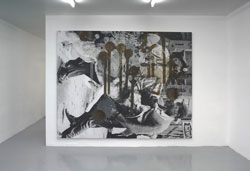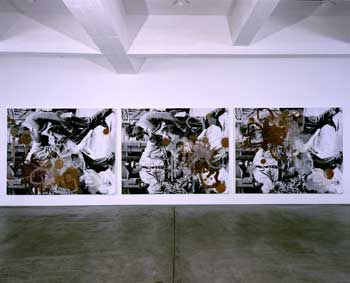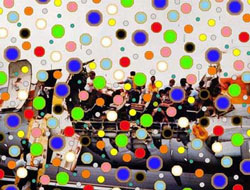



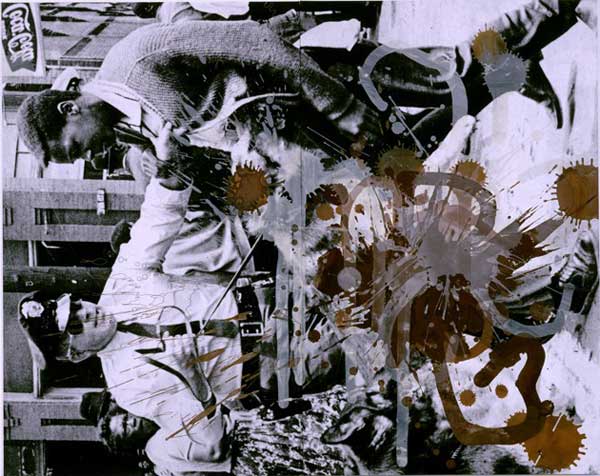
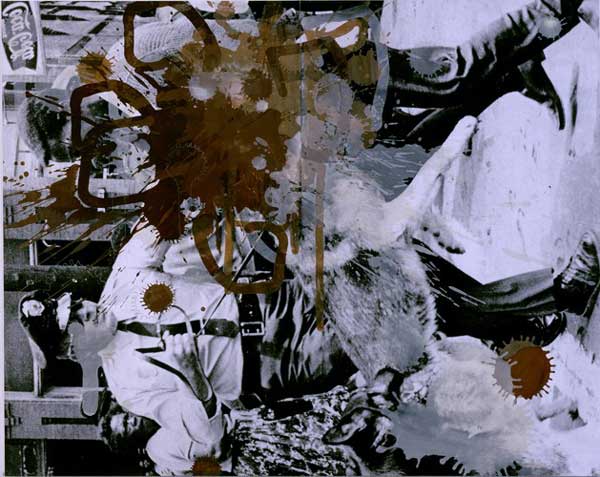

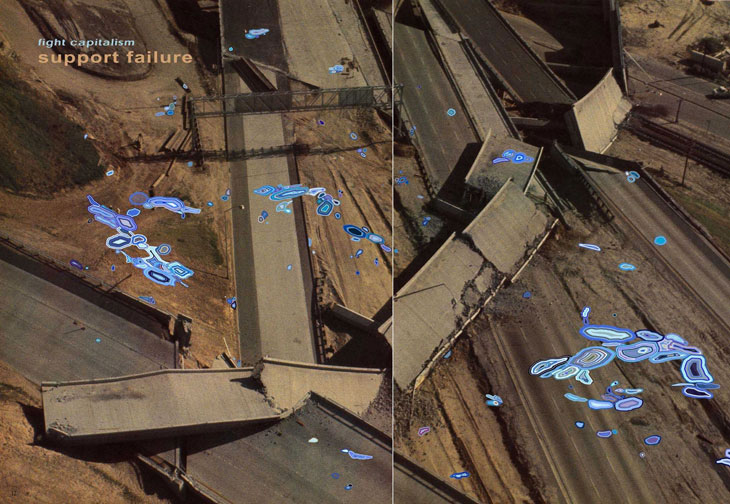


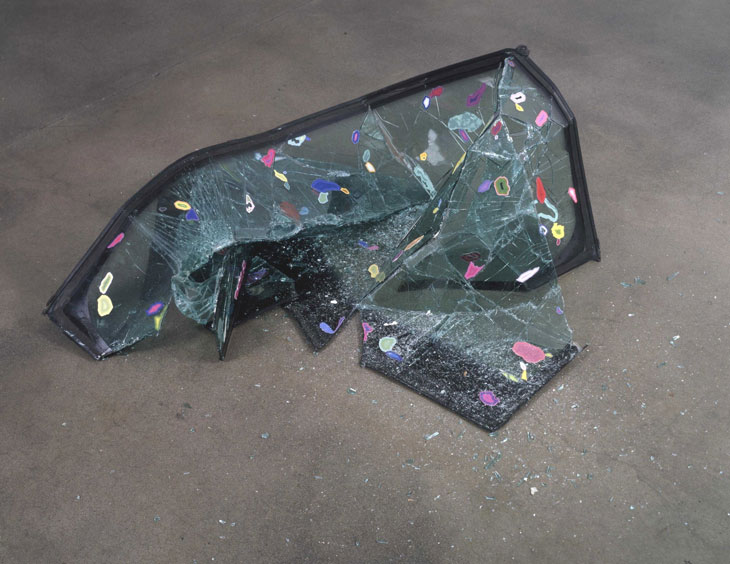


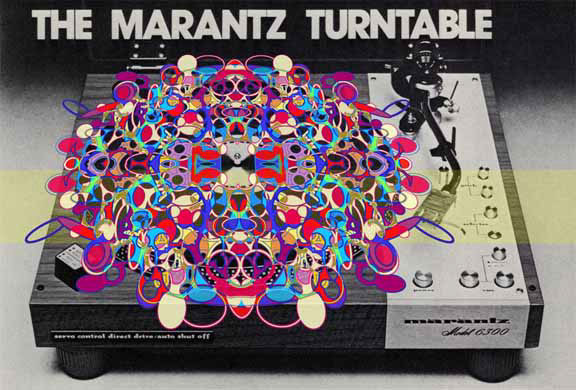
Kelley Walker
Using the potency of advertising media, Kelley Walker’s prints appropriate iconic cultural images, digitally altering them to highlight underlying issues of politics and consumerism. In Black Star Press, Walker presents large-scale billboard-like canvases of racial unrest. Set at 90 degree angles, the images of a white policeman and black youth literally portray a world turned on end. Splattered with abstracted patterns in symbolic white and chocolate, Walker’s gestures mimic violence and contrast, merging ethical corruption and graffiti pop. Printed as a dyptich, Black Star Press is desensitised through repetition, replicating the multiplicity of mass media as vast fields of anesthetised brutality.
Kelley Walker ‘s schema... recodes the interpretation of media. Using the front cover of King magazine, a publication vocal in its support of curvaceous women (rather than the mainstream too-thin ideal) as a proactive statement, Walker bathes hip-hop diva Trina in a variety of dental products (promising extra whitening effects). Using wry humour, Walker examines the underlying politics of ethnic and sexual representation as marketing strategies. Printing his digitised photos onto traditional canvases, Kelley Walker frames the disposable transience of advertising in the realm of high art; the immediacy of his images gains momentum as objects of critical contemplation, and lasting icons of social representation.
Authorship and authenticity are primary concerns within Kelley Walker’s work. Hijacking material from the public domain, Kelley further complicates the everyday transaction of images, converting the banality of information media into instances of sublime horror. In He tried to become so familiar with his equipment that using it became as automatic as driving a car, Kelley enlarges a political advertisement to grand scale, converting the original press photo cum propaganda into a fiction, removed from context one step too far. Spattering the image with abstracted puddles of electric blue, Walker turns castastrophe and instigation of protest into video game violence, portraying the morbid pastime of an unseen super-villain. Drawing allusions to terrorism, Walker highlights a more subtle threat: the potency of media as both cause and symptom of anxiety and instability.
Using the famous Maui air crash photo which appeared on the cover of Benetton’s magazine Colours in 1995, Kelley Walker explores the currency of media images as a platform where abjection and desire become indistinguishable. Obscuring the picture with a mesh of candy-coloured dots, Walker visualises the clothing company’s ‘united colours’ slogan, and makes reference to the pixelised format of digital media. Maui is both appealing and appalling: exposing the malleable nature of the meaning of images, Walker questions a world order where human value is calibrated equally by fashion and trauma.
Extending beyond ad-busting, Kelley Walker’s computerised images don’t target specific institutions or causes, but rather critically expose the constant state of anxiety within contemporary culture. We Joked That Under The Paving Slabs There Was Gold turns innocuous folly into apocalyptic nightmare. Starting with an anti-capitalist poster that radically subverts the interpretation of disaster, Walker intervenes with a no-holds-barred addition to the dread. Mal-construing the poster’s invitation to ‘explore interspatial relationships’, Walker fills the gaps of the pictured road collapse with a river of toxic orange: encompassing the title’s pursuit of riches and the advertisement’s violent message into a supernatural Armageddon, rendered with trippy day-glo seduction.
Set on the gallery floor as the aftermath of a fatal wreck, Kelley Walker’s Untitled evokes disturbing narratives. Encapsulating beauty and horror, the twisted and smashed windshield takes on a formalist intrigue and decorative desirability, as slivered glass gleans as diamond dust and amoeba-like splotches of paint glow with ornamental celebration. As with all accident scenes, the chilling truth lies in the forensic evidence: coated with candy coloured stains, Walker’s untitled portrays a head-on collision with something abstract and seductive, a deadly force with all the frivolous characteristics of Pop.
Using the cover of African-American lads’ mag King, Kelley Walker gives consumerist response to media provocation. Succumbing to the temptations of Hollywood beauty Regina Hall, Walker offers his enduring lust in the form of lewd and raunchy ‘splatter painting’. Drawing ironic entendres from the humorous Pollock reference, Walker’s expressionism is actually made from squirting popular brands of toothpaste over the image, then scanning it into his computer. Raising complex issues of race, gender, body image, and representation, Walker offers one abject product to counter another, rendering them both infinitely more appealing.
Combining the Zen of advertising with the metaphysical qualities of abstract painting, Kelley Walker’s Marantz Model… encapsulates an uneasy spiritualism of a lost generation. Overlaying a 70s advert for a stereo classic with geometric patterns, Walker sets consumer product as the basis of escapism. Cutting through the centre with a translucent yellow band, and obscuring the turntable with a psychedelic pattern, Walker makes reference to Barnett Newman’s transcendental colourfields, and the mandalas used in Buddhist meditation, reducing both to a concept of design. Rendered through computer manipulation, Walker’s iconic image is manufactured and hollow; a sentiment echoed in the stereo’s instruction label reading ‘auto shut off’.
